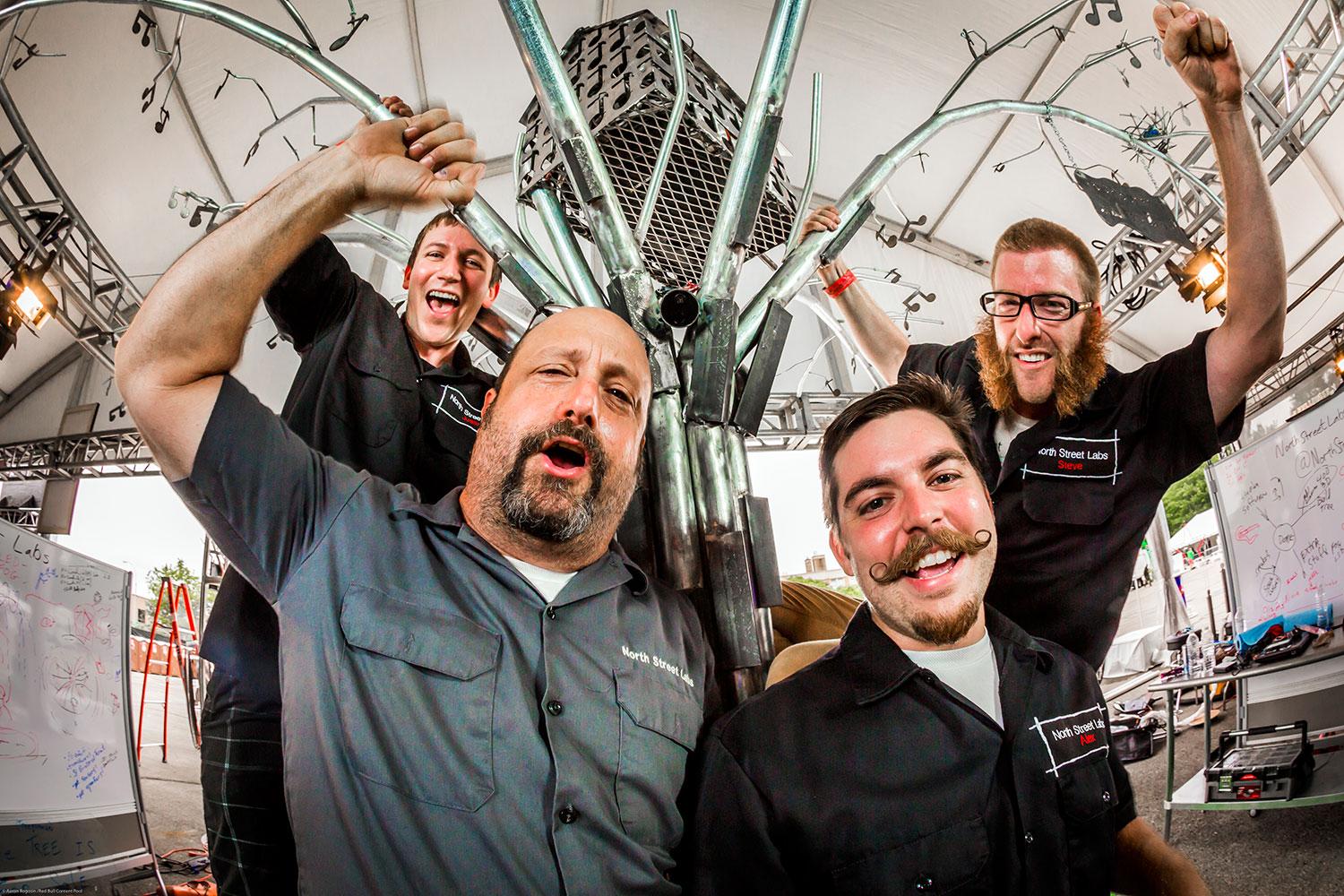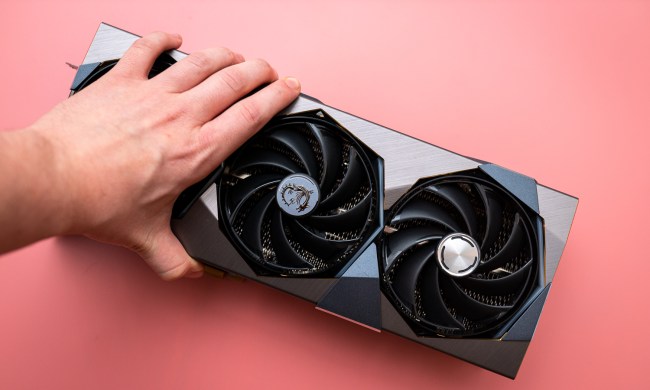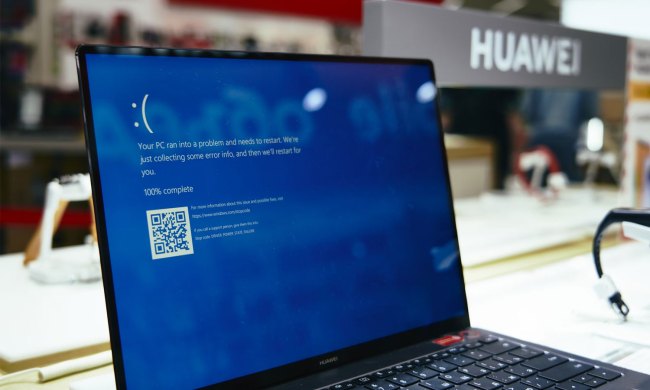
As an ominous derecho storm drilled down on the East Coast in mid-June, most New Yorkers watched the torrential downpour from inside, safe and dry. But that wasn’t the case for the four team members of Portsmouth, Virgina-based North Street Labs (NSL), and the other five teams competing in the annual 72-hour Red Bull Creation challenge (RBC). A giant tent set up in Brooklyn’s McCarren Park covered the group of makers, hackers, and builders who travelled from around the country to compete and win the grand prize of $10,000.
As the rain crawled its way into the tent, toward Medusa-like tangles of wires and cords, the only person who seemed concerned about the combination of electricity and water was me. There’s no time for worrying in a 72-hour-long buildathon.
…RBC is kind of like a “summer camp for awesome people … and crazy people.”
With this year’s topic revolving around music – a topic NSL has never messed with – the rain was the least of their worries.
Qualifying with the “Tic Tac Whoa”
North Street Labs advanced from a pool of 50 competitors to earn its spot at RBC by creating the “Tic Tac Whoa,” a giant, interactive Tic-tac-toe game. Each video submission had to showcase an interactive LED art invention built using this year’s custom-designed piece of hardware, the “TurBULL Encabulator” circuit board.
“What we wanted to do was take LEDs, add it to something not original, and turn it into something original to us,” North Street’s Alex Watson, 25, said.

Though the team had plenty of time to create their qualifying entry, the real test is building a project in less than three days on a topic you can’t prepare for. This year’s topic, announced the night before building started, was “Signal to Noise.” The challenge was to make a new musical instrument. Besides a ban on flamethrowers (park ordinances), there were very few rules. “We’ve wanted to do the music topic for a long, long time now,” Jason Naumoff, Red Bull Creation’s competition director, told us, explaining that RBC is kind of like a “summer camp for awesome people … and crazy people.”
And so it begins
Naumoff says the idea for RBC started about 10 years ago. “We’d sort of lock ourselves in the house for the weekend, and try to build something with just the materials on hand.” Naumoff said. “The things that would come out of those sessions were always really surprising and cool, and then the idea of doing a much bigger version of this sort of ‘lock-in creativity competition’ came from that.”
The first year had 16 teams competing with fewer resources, and a more lax judging method. The theme, “Energy and Motion,” was anything that would move a person from point A to point B without using a fossil fuel. Giant hamster wheels, and CO2-powered trikes were a few of the projects.
Last year’s event was held remotely as a “decentralized digital event,” where video streams of teams building in their own spaces across the country were available to watch online, with a few finalists making it to New York to present their projects at the Maker Faire.
“You can Google anything … The question is whether you can absorb it fast enough.”
Only six teams were picked this year, which meant more resources and space in the shop. Nearly every tool imaginable, including 3D printers, laser and plasma cutters, and welding and cutting machines, were made available to the teams, as well any materials they brought or could conjure up in New York City – some teams, like NSL, even overnighted parts from afar.
An idea is born
For their instrument, NSL dreamed of creating a giant tree out of steel pipes, embedded with sensors so that people could dance around it and make music. The idea was to use off-the-shelf microcontrollers connected with motion sensors to play audio clips from a digital storage device. Using eight ultrasonic and Doppler sensors, the tree would know when a person stood underneath the branches and how fast they moved around it. Different sections of the tree would have different sensors, some detecting the person’s presence and establishing a basic beat, and others making the sounds that became the melodies. That was the idea, anyway.
Day 1: Construction
With two prior competitions under their belts, NSL felt confident that they wouldn’t be scrambling down to the wire on the last day, because they planned to handle the brunt of the construction – cutting, bending, welding – on the first day.
A TorchMate plasma CNC machine, which can cut materials with extreme precision using coded instructions, worked for hours cutting out close to 400 musical notes from metal. These became the tree’s leaves.
“This is a whole different animal, and we’re learning as we go,” Justin Seemueller, 28, said about building a project based around music.

By the evening on the first day, the structure of NSL’s project was almost complete. It appeared they were the only team who’d made this kind of progress. But they had their work cut out for them, in terms of the software and wiring of the tree.
Despite the torrential downpour and having to wait until the next day for the package of critical sensors, NSL seemed calm and confident. They knew from years past the repercussions of not getting enough sleep and drinking way too much Red Bull to make up for it.
“The first year, we stayed up for the entire 72 hours,” Watson said. “After the first 18 hours, it starts to show; you start making silly mistakes that you wouldn’t normally make.” Luckily, this year, Seemueller, who works as a respiratory therapist in a hospital, came up with a sleep schedule for the group that would give them the minimum sleep needed to still function well.
Meet the gang
Seemueller, whose day job involves putting people on life support – and taking them off it – clearly deals with a lot of heavy stuff. Creating projects with NSL is one of his outlets. And, luckily for the rest of the team, Seemueller also bankrolls the majority of NSL’s projects.
Friends since middle school, Seemueller and Shaffer are also roommates, and – until very recently – were building their projects in their apartment (as well as building projects for their apartment, like their DIY stadium-seating theater). Shaffer, who sports an impressive pair of muttonchops, is nearing the completion of a double major in computer and electrical engineering.
When not in school or working on dangerous creations like the TriFly, an electric propeller-driven land vehicle that they took through a drive-thru, Shaffer makes a living doing construction work. Shaffer has less than 50 percent of his hearing compared to the average person due to complications at child birth but hears with the help of some very expensive hearing aides. For this build, Shaffer was in charge of programming the software and choosing the sounds that would play from a speaker positioned at the top of the tree.
“Every build has its frustrations, but at the end of the day, there’s nothing better than seeing something in your head become a reality.”
Marciante says he’s 37 with his hat on and 50 with his hat off (he’s actually 50) and is equally savvy in terms of the hacker/maker scene, but is a bit older than the average team member competing in RBC (which is probably closer to early 30s). Researching hacker spaces in the Portsmouth area, Marciante came across NSL, and the guys were happy to have him. Marciante, who owns his own security-systems company, acts as a mentor figure to the group while also helping in building and creating projects.
The mighty “maker movement”
Marciante was well aware of the beginning of the maker movement, which started about eight years ago and was kicked off by Make magazine, and the availability of the Arduino, a microcontroller that’s easy for people of all skill levels to use. “Prior to that, it was just a geek in his room,” Marciante said. “Make really brought the community together.”
There was a need for a space where people could just hang out, come up with ideas and build stuff – usually without any sort of financial motivation, Naumoff told us, stressing that the non-monetary aspect was something they’ve always strived to capture with the competition. “We never wanted to ask someone to prototype something you could sell or make a business out of,” he said. “We always try to keep an element of purity and whimsy to it.”
With hacker spaces like Alpha One Labs, NYC Resistor, and MakerBot, the New York City area has become a thriving hub for the maker scene, and the place for RBC.
Day 2: Not so confident
After about 4.5 hours of sleep the first night, the team returned on day two to a problem: their parts arrived, but the eight ultrasonic sensors were missing. In a rush to gather materials and make purchases within a few hours on the first day, Shaffer had failed to verify the entire order. Seemueller admitted he wasn’t feeling as confident as he was the night before.
Scrambling to find alternatives, the team ended up using a Ping))) ultrasonic distance sensor, which they bought from RadioShack that day; an X-band microwave motion detector capable of detecting speed of movement up to 40 feet away, which was given to them by a fellow RBC team, 1.21 Jigawatts; and two MaxBotix EZ1 sensors that were “sourced from a local electronics guru” according to Shaffer. The team ended up using half the number of sensors they had originally planned for.

Without any experience with music programs, Shaffer had to learn MIDI protocol on the fly. “You can Google anything,” Shaffer said. “The question is whether you can absorb it fast enough.” With four tube-shaped sensor houses built around the top of the tree for the sensors to sit in, all that was left was for Shaffer to program each of the four sensors individually.
The build space was extremely loud. Music was pumped in over speakers, and the sounds of heavy machinery were constant. “If I wasn’t the programmer, that’d be great,” Shaffer laughed. “But I’m the programmer, and I’m deaf.” Away from the noise, Shaffer spent the day in his hotel writing the code and dancing around his room to test the sensors.
Sometime after 8 p.m., Shaffer, a man with an always-positive attitude, was still in high spirits. “We’ll be dancing under this tree tomorrow morning,” he said, even though the sensors’ houses were still empty.
In the meantime, dubbing it the “Treequencer,” the rest of the team added a birdhouse made out of the discarded metal their music note “leaves” were cut out of to hold the speaker, and welded together extra metal “twigs” to make a nest. They also 3D-printed eggs for the nest, as well as a red owl to sit outside the birdhouse. With less than 24 hours left, and other teams’ creations really starting to take shape, the competition was getting noticeably close.
The final countdown
On Saturday, with less than five hours to go, Shaffer brought the sensors out from his hotel room and the team finally started putting them in the tree, which took about two hours. “We were finally able to hear it, just before the band started playing,” Shaffer said – and it wasn’t at all what he thought it would sound like. “My programming is horrible,” Shaffer laughed.
One sensor was constantly ringing – only stopping when you put your hand near it – and the other sensors were so quiet that they were hard to hear at all. Seemueller wanted to play with the sound more, but Shaffer disagreed. “Every time,” Seemueller said about troubleshooting down to the wire.
“When you’re a maker, you can make shit happen.”
What did the tree end up sounding like? “It was like a random musical instrument that could make some cool noises,” Shaffer admits. “One of the guys had the idea of a five-note piano scale, but it turns out that no one really noticed that, and no one played with that.” Shaffer put the scale on two out of the four sensors. “It turned out two out of the four sensors sucked,” he laughed.
With the venue being so loud, NSL put the finishing touches on the Treequencer as best they could, adding branches with leaves that blew in during the derecho, and adding Astroturf and woodchips around its base. Though other teams’ projects may have sounded better, NSL’s 10-foot tall Treequencer was a genuine work of art – something that could be part of a sculpture garden. In fact, on Sunday, someone came by who was interested in buying it.

Putting down their tools and finishing with 15 minutes to spare, the team walked over to have a much-deserved beer and toast to their creation. Seemueller still lamented the need for more software tweaking. “Everything else is perfect.”
NSL used the most technology it’s ever used in a single build during this year’s RBC, using “wireless sensors, every tool imaginable, laser cutting (for the sensor covers), CNC plasma cutting (for the notes and the Treequencer’s sign), heavy duty hydraulic tools (to bend the pipes), programming, and soldering,” according to Seemueller.
It’s foosball time!
Minutes after the clock struck zero and the teams all cheered, breathing a sigh of relief, Watson and Seemueller were found at the foosball table, while Shaffer was already involved in a ping-pong match. “It’s purely fun,” Seemueller said.“ Every build has its frustrations, but at the end of the day, there’s nothing better than seeing something in your head become a reality.”
Eventually, after more years of losing, nobody will be able to beat us … it’ll become impossible.”
One of the sensors, which Shaffer programmed to sound like a regular piano, correlated to the distance of a person’s hand to the pitch of the piano. The problem was, it bottomed out on the ground at the highest note on the piano, so it was always on because it saw the ground. This was the sound we heard the day before that was continually playing – imagine someone hitting a high note on a keyboard over and over and over again. Surprisingly, Shaffer didn’t change that on Sunday. “I’m deaf, so it didn’t sound that bad,” Shaffer laughed.
In addition to a drum, the other two sensors consisted of a low bass synth piano, and a weird, ethereal-sounding one that Shaffer said he added because “he couldn’t help himself.” This one didn’t matter where you put your hand; it just played the “echo-y space bird” sound.
As festivalgoers walked up to the massive tree on Sunday, they moved their hands from sensor to sensor to play with the different notes of the piano, the variance in drum beats, and explore the alien-like sounds of the last sensor.
“The user has to learn the tree,” Shaffer said. “They have to learn how to move around it to actually make good music, and we saw a couple of people do that during the fair.” Once you spend a little time with each sensor, you can position yourself in a way that you can move both hands to opposite sides of the tree, and have your body activate the sensor in front of you. “A couple people started making some beats,” Shaffer said. “They had a little thing going.”
‘You have to lose before you can win’
No, NSL didn’t end up winning. MB Labs, a team from Chicago, won the $10,000 with its so-called “Autoloop” drum-machine concept. One judge, Dan Frel, told us it was the most fun in terms of interactivity and worked the best. “The tree was a strong runner up because it looks amazing and has good interactivity,” Frel said. Greg Needel, head judge, told us that NSL had the highest score in the “aesthetics” category.
Still, NSL was completely happy with the build. “Losing is nothing new to us,” Shaffer said. “You have to lose before you can win.”
And though the team didn’t win first place, NSL still walked away ahead: They estimate they’re getting about $2,000 in tools, at least $300 in welding wire, about 100 pounds of nuts and bolts, and at least $300 in Red Bull. As one of the only two teams who drove to the competition, NSL were able to fill their trucks.
“Winning the cash prize is great since it helps with future projects and paying the bills,” Watson said. “But just coming here in the first place is enough.” Marciante chimed in, adding that the team’s actually glad they didn’t win because now they have more drive.
“Every year I do this, I learn something completely new, and it just makes me greater and smarter,” Shaffer said. “Eventually, after more years of losing, nobody will be able to beat us … it’ll become impossible.”
Another win for NSL: Treequencer was one of two projects selected by Red Bull headquarters to be transported to the Red Bull Music Academy recording studio for a band, Superhuman Happiness, to use, create, and record music with.
“We all have an imagination … we just don’t realize what’s possible,” Seemueller said. “When you’re a maker, you can make shit happen.” In fact, those last three words can be seen on North Street Labs’ business cards – which are cut out of plexi with their homemade CNC router, of course.
















